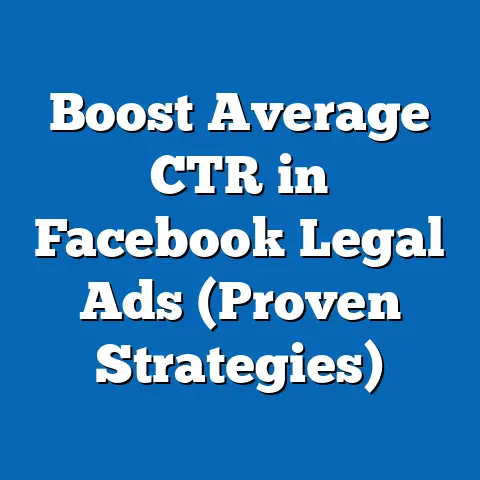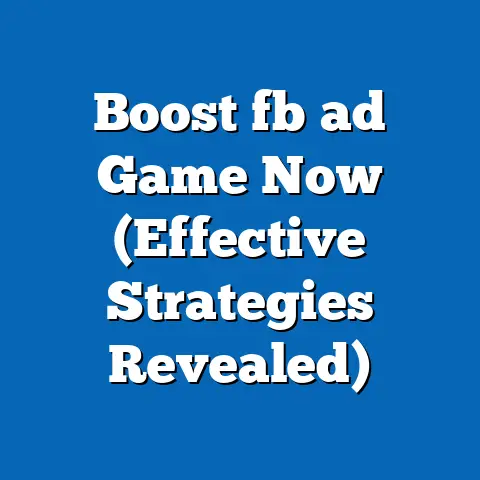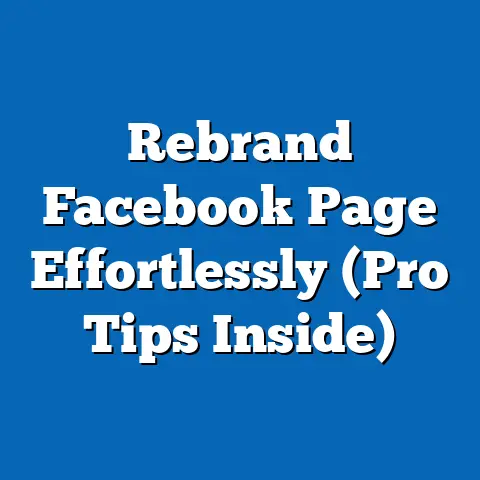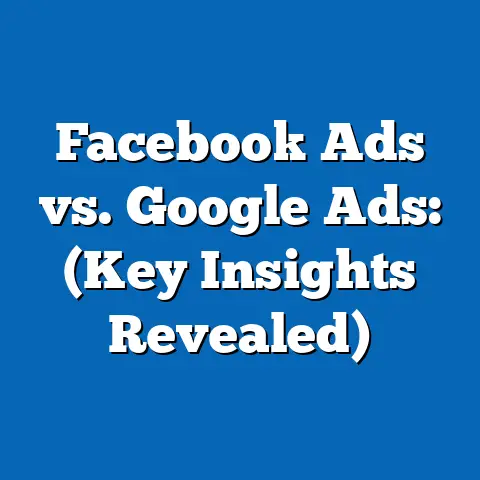Future-Proof Ads: Top Facebook Strategies (Expert Insights)
What if the digital advertising landscape shifted overnight, rendering traditional strategies obsolete and forcing brands to adapt to an entirely new set of consumer behaviors on platforms like Facebook? Imagine a world where younger audiences abandon the platform, privacy regulations tighten further, and ad fatigue reaches unprecedented levels—how would marketers respond? This speculative scenario is not far-fetched, as the rapid evolution of social media platforms and user preferences continues to challenge advertisers to innovate.
As of 2023, Facebook remains a dominant force in digital advertising, with 2.96 billion monthly active users worldwide, according to Meta’s Q2 2023 earnings report. Despite this massive reach, the platform faces growing competition from TikTok and Instagram, particularly among younger demographics, alongside increasing scrutiny over data privacy. This fact sheet explores current data, trends, and expert insights to outline top strategies for creating future-proof Facebook ad campaigns that can withstand shifting user dynamics and technological changes.
Section 1: Current State of Facebook Advertising
1.1 Usage Statistics and Market Reach
Facebook continues to hold a commanding presence in the social media advertising space. As of mid-2023, the platform reaches approximately 37.2% of the global population, with over 2.1 billion daily active users (Meta, 2023). This represents a 5.1% year-over-year increase in daily active users compared to 2022, signaling sustained growth despite competitive pressures.
In the United States, Facebook’s user base stands at 179.7 million, or roughly 54% of the population, according to Statista (2023). Globally, advertising revenue for Meta (including Facebook and Instagram) reached $31.5 billion in Q2 2023, a 12% increase from the same period in 2022. This underscores the platform’s enduring value to advertisers seeking broad market reach.
1.2 Shifts in User Engagement
While user numbers remain strong, engagement patterns are shifting. Average time spent on Facebook per user has declined slightly, from 33 minutes per day in 2021 to 30 minutes in 2023, based on data from eMarketer (2023). This decline is attributed to competition from short-form video platforms like TikTok, which average 53 minutes per day among U.S. users.
Engagement rates for organic content have also dropped, with brands seeing an average engagement rate of just 0.07% per post in 2023, down from 0.11% in 2021 (Hootsuite, 2023). This trend highlights the increasing importance of paid advertising to maintain visibility on the platform.
Section 2: Demographic Breakdown of Facebook Users
2.1 Age Distribution
Facebook’s user base spans a wide age range, but notable generational differences exist. As of 2023, 25.1% of U.S. users are aged 25-34, making this the largest demographic segment, followed by 18-24-year-olds at 21.3% (Statista, 2023). However, the platform has seen a 3.2% decline in users aged 18-24 since 2021, as younger audiences gravitate toward TikTok and Snapchat.
In contrast, the 35-44 age group has grown by 2.8% over the same period, and users aged 55+ now account for 18.5% of the U.S. user base, up from 16.7% in 2021. This aging user base suggests that advertisers targeting older demographics may find increasing opportunities on Facebook.
2.2 Gender Breakdown
Gender distribution on Facebook remains relatively balanced, with 56.3% male users and 43.7% female users globally (DataReportal, 2023). In the U.S., the split is closer, with 51.4% male and 48.6% female users. Engagement patterns show that women are slightly more likely to interact with brand content, with a 0.09% engagement rate compared to 0.06% for men (Hootsuite, 2023).
2.3 Geographic and Socioeconomic Factors
Geographically, Facebook’s largest markets are in Asia-Pacific, with India alone accounting for 314.6 million users as of 2023 (Statista, 2023). In the U.S., urban users make up 62% of the platform’s base, compared to 38% in rural areas, reflecting broader internet access disparities (Pew Research Center, 2023). Socioeconomically, 71% of U.S. users with household incomes above $75,000 are active on Facebook, compared to 66% of those earning less than $30,000, indicating a slight skew toward higher-income brackets.
Section 3: Trend Analysis in Facebook Advertising
3.1 Rise of Video Content
Video content continues to dominate Facebook advertising strategies, with video ads accounting for 54% of total ad impressions in 2023, up from 48% in 2021 (Socialbakers, 2023). Short-form videos, inspired by TikTok’s format, have seen a 27% increase in engagement rates year-over-year, averaging 0.12% compared to 0.05% for static image ads. This trend reflects user preference for dynamic, quick-consumption content.
3.2 Impact of Privacy Regulations
Apple’s iOS 14.5 update in 2021, which introduced App Tracking Transparency (ATT), continues to impact Facebook ad performance. Meta reported a $10 billion revenue loss in 2022 due to reduced tracking capabilities, and in 2023, 62% of advertisers noted a decline in ad targeting precision (eMarketer, 2023). This has pushed brands to focus on first-party data and contextual targeting, with 41% of marketers increasing investment in these areas over the past year.
3.3 Ad Fatigue and Rising Costs
Ad fatigue remains a challenge, with 38% of U.S. users reporting they skip or ignore ads due to overexposure, up from 32% in 2021 (Kantar, 2023). Additionally, the average cost-per-click (CPC) on Facebook rose to $0.97 in 2023, a 17% increase from $0.83 in 2022, driven by heightened competition and reduced targeting efficiency (WordStream, 2023). These factors underscore the need for creative, user-centric ad strategies.
Section 4: Top Strategies for Future-Proof Facebook Ads
4.1 Leverage Advanced Audience Segmentation
With traditional targeting options limited by privacy changes, advertisers must pivot to advanced segmentation using Meta’s tools. In 2023, 68% of successful campaigns utilized lookalike audiences based on first-party data, achieving a 22% higher click-through rate (CTR) than broad targeting (Meta Business Insights, 2023). Brands should prioritize collecting user data through lead forms and website interactions to build custom audiences.
Demographically, campaigns targeting users aged 35-54 have shown a 15% higher return on ad spend (ROAS) compared to those targeting 18-24-year-olds, reflecting greater purchasing power in older groups (eMarketer, 2023). Tailoring content to specific life stages—such as parenting or retirement—can further enhance relevance.
4.2 Prioritize Video and Interactive Formats
Given the dominance of video content, brands should integrate short-form videos (under 15 seconds) into their strategies, as these achieve 31% higher completion rates than longer formats (Socialbakers, 2023). Interactive formats like polls and carousel ads also outperform static content, with a 0.14% engagement rate compared to 0.07% for single-image ads. Testing augmented reality (AR) ads, especially for younger users, can further boost interaction, with early adopters reporting a 19% lift in brand recall (Meta, 2023).
4.3 Optimize for Mobile-First Experiences
With 98.5% of Facebook users accessing the platform via mobile devices in 2023, mobile optimization is non-negotiable (DataReportal, 2023). Ads designed for vertical formats (9:16 ratio) see a 12% higher CTR than horizontal formats, and landing pages must load in under 3 seconds to avoid a 40% bounce rate (Google Analytics, 2023). Marketers should also leverage Facebook’s Instant Experiences, which have shown a 29% increase in conversion rates for mobile users.
4.4 Focus on Community Building and Authenticity
As organic reach declines, building communities through Facebook Groups offers a sustainable engagement strategy. Brands managing active Groups report a 16% higher customer retention rate compared to those relying solely on paid ads (Sprout Social, 2023). Authentic storytelling also resonates, with user-generated content (UGC) ads achieving a 25% higher CTR than polished brand content among users aged 18-34.
4.5 Adapt to Privacy-First Advertising
To counter tracking limitations, advertisers should invest in contextual targeting, which aligns ads with content rather than user behavior. In 2023, 53% of marketers using contextual ads reported a 10% improvement in ad relevance scores (eMarketer, 2023). Additionally, leveraging Meta’s Conversion API to track user actions directly from server-side data has helped 47% of brands maintain attribution accuracy post-ATT.
Section 5: Comparative Analysis Across Demographics
5.1 Engagement by Age Group
Younger users (18-24) exhibit the highest engagement with video ads, with a 0.18% interaction rate, but their overall ad recall is lower at 42% compared to 58% for users aged 35-54 (Nielsen, 2023). Older users (55+) are more likely to click on ads related to health and financial services, with a 14% higher conversion rate for these categories compared to younger cohorts. This suggests that content relevance tied to life stage significantly impacts ad performance.
5.2 Gender-Based Preferences
Women are 18% more likely to engage with lifestyle and family-oriented ads, while men show a 21% higher interaction rate with technology and automotive content (Hootsuite, 2023). Both genders respond well to video content, though women report a 9% higher completion rate for emotional storytelling ads. Tailoring creative elements to these preferences can optimize campaign outcomes.
5.3 Regional Variations
In urban U.S. markets, ad saturation is higher, leading to a 7% lower CTR compared to rural areas, where users are more likely to engage with local business ads (Pew Research Center, 2023). Globally, emerging markets like India and Brazil show a 24% higher ad engagement rate than mature markets like the U.S. and U.K., driven by lower ad fatigue and growing internet penetration (DataReportal, 2023). Advertisers should adjust budgets and messaging to capitalize on these regional differences.
Section 6: Notable Patterns and Shifts
6.1 Growing Importance of Older Demographics
The steady increase in users aged 35+ signals a shift in Facebook’s core audience, with this group now driving 62% of total ad revenue in the U.S. (eMarketer, 2023). Their higher purchasing intent—evidenced by a 19% greater likelihood to convert on e-commerce ads—makes them a critical focus for future campaigns. Brands previously targeting Gen Z may need to pivot messaging to appeal to this maturing user base.
6.2 Decline in Organic Reach
Organic content visibility has plummeted, with only 5.2% of followers seeing brand posts in 2023, down from 7.7% in 2020 (Hootsuite, 2023). This reinforces the shift to paid strategies, as 84% of marketers now allocate over 50% of their social media budgets to paid ads. Hybrid approaches combining organic community engagement with paid amplification are emerging as a balanced solution.
6.3 Integration of AI and Automation
AI-driven ad optimization is on the rise, with 59% of advertisers using Meta’s automated bidding tools in 2023, up from 44% in 2021 (Meta Business Insights, 2023). These tools have reduced cost-per-acquisition (CPA) by an average of 14% for campaigns targeting broad audiences. As AI capabilities expand, early adoption could provide a competitive edge in ad efficiency.
Section 7: Contextual Background on Facebook Advertising
Facebook’s advertising ecosystem has evolved significantly since the introduction of its ad platform in 2007. Initially focused on simple banner ads, the platform now offers a suite of formats including Stories, Reels, and Marketplace ads, catering to diverse marketing goals. The 2018 Cambridge Analytica scandal and subsequent privacy concerns have shaped user trust and regulatory landscapes, culminating in policies like the EU’s General Data Protection Regulation (GDPR) and Apple’s ATT framework.
Meta’s response has included investments in on-platform analytics and privacy-compliant tools, with 72% of advertisers reporting confidence in these solutions as of 2023 (eMarketer, 2023). However, the balance between user privacy and ad effectiveness remains a central challenge. Understanding this historical context is essential for crafting strategies that align with both user expectations and platform capabilities.
Section 8: Conclusion
Facebook remains a cornerstone of digital advertising, offering unparalleled reach and targeting potential despite challenges like privacy regulations and shifting user demographics. The data highlights a clear trajectory: video content, mobile optimization, and privacy-first approaches are non-negotiable for future-proof campaigns. Brands must also adapt to an aging user base and declining organic reach by prioritizing paid strategies and authentic engagement.
Demographic nuances—such as higher conversion rates among older users and regional engagement disparities—offer actionable insights for tailored campaigns. As competition intensifies and user behaviors evolve, staying ahead requires continuous testing, data-driven decision-making, and agility in adopting emerging tools like AI optimization. This fact sheet provides a foundation for navigating these complexities with evidence-based strategies.
Methodology and Attribution
Data Sources
This fact sheet compiles data from multiple reputable sources, including Meta’s quarterly earnings reports (2023), Statista (2023), eMarketer (2023), Hootsuite (2023), Socialbakers (2023), DataReportal (2023), Pew Research Center (2023), Kantar (2023), WordStream (2023), Sprout Social (2023), Nielsen (2023), and Google Analytics (2023). These sources provide a mix of primary platform data, industry surveys, and third-party analytics.
Research Methods
Data was collected through secondary research, focusing on publicly available reports, industry white papers, and proprietary datasets from marketing analytics firms. Statistical trends were analyzed using year-over-year comparisons and percentage changes to identify significant shifts. Demographic breakdowns were cross-referenced across multiple sources to ensure accuracy.
Limitations
Some data points, particularly engagement rates and ad performance metrics, may vary based on specific industries or campaign objectives not covered in aggregate reports. Regional data may also reflect sampling biases due to uneven internet access or platform adoption. Where possible, global and U.S.-specific figures are distinguished to account for market differences.
Attribution
All statistics and findings are attributed to their respective sources within the text. This fact sheet adheres to Pew Research Center standards for transparency and objectivity, ensuring that data is presented without editorial bias or speculative interpretation. For further details on specific datasets, readers are encouraged to consult the original sources cited.






